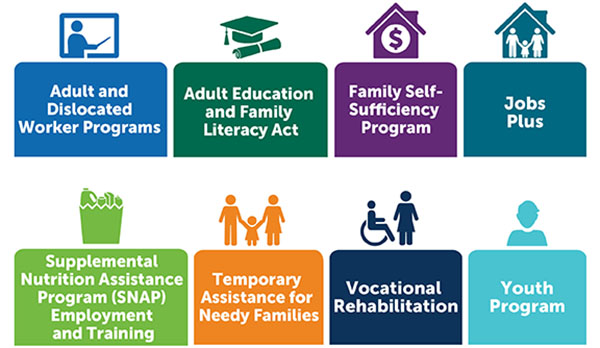A new study sheds light on how human services and workforce agencies can align indicators of program performance in ways that might increase coordination and improve services to people with low incomes. As part of the EMPOWERED study, Mathematica experts examined several programs that have performance indicators defined at the federal level—such as Temporary Assistance for Needy Families (TANF), the programs reauthorized by the Workforce Innovation and Opportunity Act of 2014, and others depicted in the figure above. The study provides additional insight regarding variation in program philosophies, policy goals, and targeted populations, which has resulted in different indicators to measure performance. This widespread variation, and dissimilar data systems, can make it difficult for states and the federal government to align measures of program performance in ways that might improve service coordination and help individuals achieve self-sufficiency.
To address these issues, a new brief from the study team summarizes key policy considerations for aligning performance indicators. A second brief outlines actionable steps to align federal performance indicators across programs that promote self-sufficiency. These recommendations include the following:
Key considerations for policymakers include creating a flexible framework of performance indicators so programs can select those that best reflect their needs. Policymakers can also develop methods for setting performance targets that account for differences in program services. Read four more considerations for policymakers in the brief.
Actionable steps for program design and practice include developing common indicators within and across programs to supplement high-level federal performance measures, as well as building a data infrastructure that provides information to guide program management and service coordination, in addition to tracking performance. Discover more actionable steps for program administrators in the brief.
About the EMPOWERED study: Mathematica conducted the study for the Office of the Assistant Secretary for Planning and Evaluation (ASPE) at the U.S. Department of Health and Human Services. Mathematica and ASPE collaborated closely with national and federal stakeholders and local program staff to translate big questions into deep insights that improve programs, refine strategies, and enhance understanding. Other briefs recently released as part of this project include (1) an examination of local perspectives on the challenges and opportunities for aligning performance indicators across a variety of federal programs promoting self-sufficiency and (2) a review of child support cooperation requirements in child care subsidy programs and the Supplemental Nutrition Assistance Program. An additional brief, focused on work requirements, is forthcoming.


